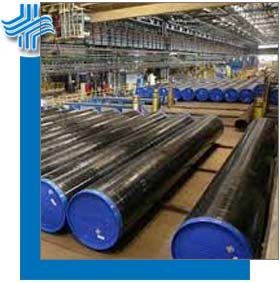October 7, 2023
Unveiling Excellence: Understanding ASTM A335 P22 and API 5L Grade B
1.3k
In the dynamic landscape of steel and materials engineering, the demand for high-performance alloys and standardized materials has never been higher. Two key players in this arena are ASTM A335 P22 and API 5L Grade B. These materials have made significant contributions to various industries, thanks to their exceptional properties and versatile applications. In this article, we will delve into the world of ASTM A335 P22 and API 5L Grade B, exploring their significance, characteristics, and the vital roles they play in diverse sectors.
ASTM A335 P22: The Powerhouse Alloy: ASTM A335 P22 is a remarkable alloy steel known for its outstanding performance in high-temperature and high-pressure environments. It is a part of the ASTM A335 standard, which covers seamless ferritic alloy-steel pipe for high-temperature service. Let's take a closer look at the key attributes and applications of ASTM A335 P22:
- High-Temperature Strength: ASTM A335 P22 exhibits exceptional strength and stability at elevated temperatures, making it a prime choice for applications in power generation, petrochemical plants, and refineries. It can endure temperatures up to 600°C (1112°F) without compromising its structural integrity.
- Corrosion Resistance: The alloy's composition includes chromium and molybdenum, which enhance its corrosion resistance. This property is critical for applications in aggressive and corrosive environments.
- Versatility: ASTM A335 P22 finds applications in a wide range of industries, including oil and gas, chemical processing, and power generation. Its ability to handle high-pressure conditions and extreme temperatures makes it a versatile material for various engineering projects.
- Ease of Welding: Welding ASTM A335 P22 is relatively straightforward, simplifying installation and maintenance. This feature minimizes downtime, ultimately benefiting project efficiency and cost-effectiveness.
- Cost Efficiency: Despite its exceptional performance under extreme conditions, ASTM A335 P22 offers a cost-effective solution compared to some other high-performance materials. This affordability makes it an attractive choice for budget-conscious projects.
API 5L Grade B: The Backbone of Oil and Gas: API 5L Grade B is a high-strength carbon steel used primarily in the oil and gas industry for the transportation of fluids and gases. It is part of the API 5L standard, which sets the specifications for line pipe materials. API 5L Grade B has garnered widespread recognition for its durability and reliability in critical applications. Let's explore its key features and roles in the industry:
- High Strength: API 5L Grade B offers exceptional strength, making it well-suited for the rigorous demands of the oil and gas sector. It is used in pipelines for the safe and efficient transport of hydrocarbons, natural gas, and other fluids.
- Corrosion Resistance: While not as corrosion-resistant as some alloy steels, API 5L Grade B is designed to resist corrosion effectively when coated or lined appropriately. This makes it suitable for applications in both onshore and offshore environments.
- Standardization: API 5L Grade B is governed by strict industry standards, ensuring uniform quality and consistency. This standardization is crucial in the oil and gas sector, where safety and reliability are paramount.
- Versatility: Apart from its primary use in the oil and gas industry, API 5L Grade B can also find applications in water distribution, structural components, and construction projects.
- Economical Solution: In the oil and gas sector, where extensive pipeline networks are required, API 5L Grade B offers an economical solution without compromising on performance. Its affordability plays a pivotal role in the industry's cost-efficiency.
Applications in Key Industries: Both ASTM A335 P22 and API 5L Grade B play pivotal roles in various industries, contributing to progress and development:
ASTM A335 P22 Applications:
- Power Generation: In power plants, where high-temperature and high-pressure conditions are the norm, ASTM A335 P22 is used in boiler tubes, superheaters, and heat exchangers to ensure efficient energy generation.
- Petrochemical Industry: ASTM A335 P22's corrosion resistance and strength make it suitable for critical components in petrochemical plants, where it helps maintain the integrity of pipelines, reactors, and vessels.
- Refineries: In refineries, the alloy's ability to withstand harsh environments and extreme temperatures ensures the safety and efficiency of refining processes.
- Chemical Processing: ASTM A335 P22 is used in chemical plants to handle corrosive materials, where its resistance to corrosion and high-temperature strength are indispensable.
API 5L Grade B Applications:
- Oil and Gas Industry: API 5L Grade B is the backbone of the oil and gas sector, serving as the primary material for pipelines that transport crude oil, natural gas, and other hydrocarbons from production sites to processing facilities and distribution centers.
- Water Distribution: In water distribution networks, API 5L Grade B is used for the transportation of potable water, ensuring a safe and reliable supply to communities.
- Construction: API 5L Grade B also finds applications in construction, particularly in structural components where high-strength materials are required.
Conclusion: ASTM A335 P22 and API 5L Grade B have earned their stripes as exceptional materials in the world of steel and materials engineering. Their unique properties and versatile applications make them indispensable in various industries, including power generation, petrochemicals, oil and gas, and construction. As the demand for high-performance materials continues to grow, these materials will remain at the forefront, driving innovation and progress across diverse sectors. The future holds even more potential as these materials evolve to meet the ever-changing demands of a dynamic global economy, reinforcing their significance in the world of steel and materials engineering.
